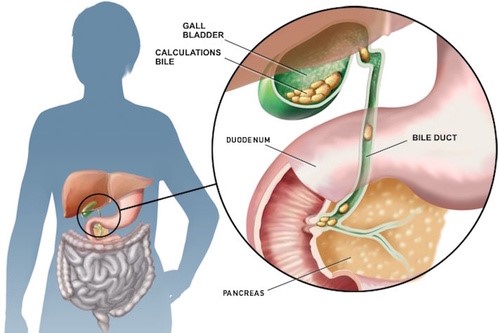
Biliary colic: how to recognise and treat it
Biliary colic is the most important symptom of people suffering from gallstones or cholelithiasis, i.e. stones, usually made up of cholesterol, that become wedged in the bile ducts
In particular, gallbladder spasm is most acute in the presence of a stone in the choledoch, the main bile duct.
It generally occurs at night and more frequently after eating large meals, especially those rich in fat.
About 8% of Italians suffer from it without experiencing any symptoms or pain.
How to recognise biliary colic
Biliary colic presents itself with acute, intermittent pain, which may recur several times over several hours, interspersed with moments of rest.
They differ from renal colic, whose pain is descending, because the pain migrates upwards, to the back and to the region below the right shoulder blade and shoulder.
The most characteristic symptom is the sharp and sudden pain in the upper abdomen and in the middle, towards the right, just below the ribs.
The pain often tends to extend to the right hip and posteriorly towards the shoulder and scapula.
The painful cramps are caused by stones passing through the cystic duct and the choledochus, which are part of the system of ducts that carry bile to the intestine.
Sometimes colic may also be accompanied by fever, nausea and vomiting, which may be a sign of further complications.
What are the other complications of gallstones?
After gallstones, the most common consequence is acute cholecystitis, i.e. inflammation of the gallbladder wall.
The pain is similar to that of colic, but more persistent, and may be accompanied by fever, which is a sign of an inflammatory process that needs to be sedated as soon as possible to avoid the risk of developing an abscess or even perforating the gallbladder.
The most feared consequence is certainly acute pancreatitis, which is caused by the migration of a stone from the gallbladder.
In such cases, the pain is so severe that the sufferer seeks help in the emergency room.
If, in addition to the typical pain of colic, there is also a yellowish discolouration of the skin and the sclerae of the eyes, obstructive jaundice is likely.
Diagnosis of biliary colic
First an abdominal ultrasound scan is carried out to reveal the stones, which are usually made up of cholesterol or, in rare cases, calcium bilirubin.
In some cases, blood tests are also performed, as some parameters may be altered, such as transaminases, lipases or amylases, which indicate acute pancreatitis.
Treatment
In the most acute stages of pain, non-steroidal anti-inflammatory drugs or antispasmodics are used after consulting the doctor.
If cholecystitis is present and inflammation of the bile ducts is suspected, antibiotic treatment is necessary.
The final solution for those who have suffered repeatedly from colic and complications is cholecystectomy, i.e. surgical removal of the gallbladder.
Read Also:
Kidney Stones: How They Form And How To Avoid Them
Renal Colic, How Does It Manifest Itself?


